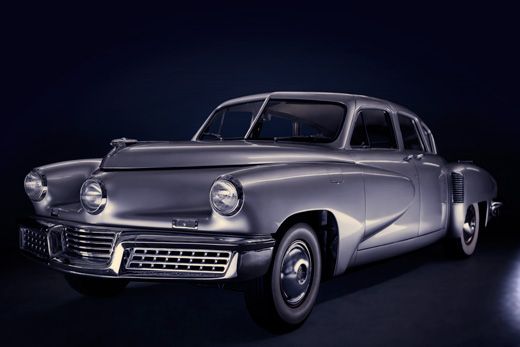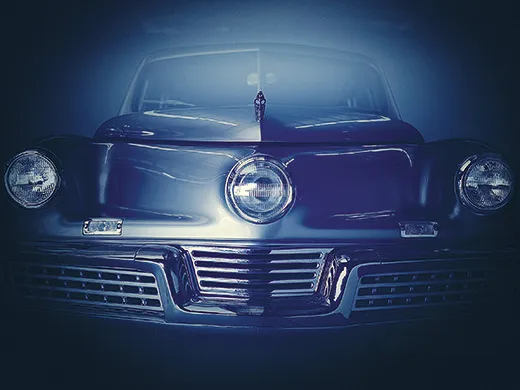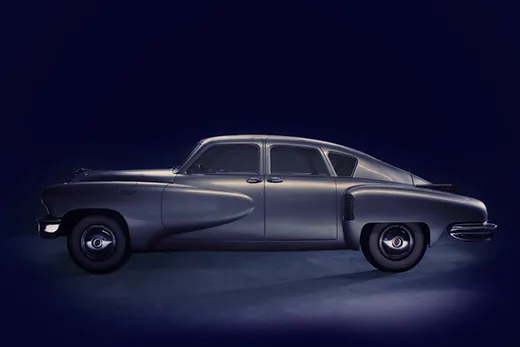The Tucker Was the 1940s Car of the Future
Visionary inventor Preston Tucker risked everything when he saw his 1948 automobile as a vehicle for change
/https://tf-cmsv2-smithsonianmag-media.s3.amazonaws.com/filer/National-Treasure-Tucker-cars-631.jpg)
Francis Ford Coppola’s car connection began at birth, or even before. He was delivered at Detroit’s Henry Ford Hospital, and Henry Ford himself sometimes attended rehearsals of the Detroit Symphony, where Coppola’s father played first flute. “In a family tradition of giving the middle name to an important family acquaintance, they gave me ‘Ford,’” the Godfather director explains.
But Coppola would soon come to admire a more obscure automotive icon: Preston Tucker, father of the unlucky Tucker ’48, a cutting-edge car that was never mass-produced because of the inventor’s legal and financial woes.
“As a child, my father told me about the new Tucker,” Coppola recounts. “He had ordered one and invested in the Tucker stock. He took me to see the car when it was on exhibit and I was very excited. I remember the details very well and for months kept asking, ‘When is the Tucker coming?’ Finally he said it was never coming, and that the big companies didn’t want it to exist, and wouldn’t let Mr. Tucker buy steel or the supplies he needed.”
Coppola’s father lost his $5,000 investment, a lot of money for a middle-class man in the 1940s, but “he didn’t blame Tucker. He loved innovation.” And to Coppola, the Tucker car became “a mythical thing.” Nearly 40 years later, Coppola directed Tucker: The Man and His Dream, a critical success that, in the Tucker tradition, failed to make money.
Today, Tucker’s 475-acre Chicago production plant houses a Tootsie Roll factory and shopping center. But 47 of the original 51 cars built there still exist in collections scattered throughout the world. Parked in a Smithsonian National Museum of American History warehouse, Number 1039 is the color of champagne. Usually up on blocks, and drained of all fluids but oil, it still emits a living glow, like a pearl.
Preston Tucker, an affable character with a weakness for statement neckties, was a Prohibition-era policeman known for chasing down boosmtleggers in Lincoln Park, Michigan. (He would be gratified to learn that the Smithsonian’s Tucker was seized during a government narcotics raid.) One frigid winter, he torched a hole in the dashboard of his unheated cruiser to pipe in warmth from under the hood, was demoted for his trouble and left the force. He later built race cars and the Tucker Turret, a swiveling machine-gun turret used in World War II.
After the war, and years of sugar and meat rationing, America’s biggest appetite was for cars. They were the keystone of the emerging suburban culture, but production had stopped entirely between 1942 and ’45, as automobile factories cranked out bomber engines and other wartime goods. There were long waiting lists for new vehicles, and consumers plunked down money, sight unseen. But the first models produced in 1946 featured tired prewar designs. Tucker knew that he could top them.
“Tucker thought of the automobile as a malleable object,” says NMAH curator Roger White. “He was kind of like Frank Lloyd Wright in that respect, unafraid to start from scratch.”
Unveiled in 1946 in a series of sketches, the Tucker Torpedo, as the sedan was called, hurtled into the future: With its swooping lines, the car appeared almost as if it were moving, even when standing still. “It was like the Star Wars of that period,” says Jay Follis, historian for the Tucker Automobile Club of America. It wasn’t only the sleek shape that resonated: The car boasted innovations including a third, centered headlight, which swiveled to light the way around corners; fenders that pivoted defensively when the car turned; disc brakes; a pop-out windshield (designed to eject during a crash, protecting passengers); a rear engine; and a padded dashboard.
But while his designs and safety innovations were pioneering, Tucker’s business model lagged. Car manufacturing had contracted during the Great Depression; by the late ’40s, only a handful of companies remained, rooted in a culture that valued corporate prudence over individual genius. By the mid-1950s, Ford, General Motors and Chrysler manufactured 95 percent of American cars.
Tucker refused to cede creative control to businessmen who could have made the Tucker ’48 commercially viable. Instead, he attempted to raise money through unconventional means, including selling dealership rights for a car that didn’t exist yet. The Securities and Exchange Commission investigated, he was tried for fraud, and although acquitted in 1950, went bankrupt. Tucker also believed that opponents in the auto industry had orchestrated his downfall. He died a few years after he went broke, still working on new designs. Some regarded him as a scam artist, others as a tragic visionary. (When a Tucker went up for sale this year, it fetched $2.9 million.)
“If someone has a beautiful dream, but doesn’t know how to achieve it, is he a great man or not?” White asks. “Whether Tucker was a great man or not, he was a quintessential American.”
Coppola, who is currently living in China working on a new project, believes that “We are a country of innovators, but we don’t always welcome them or aid them in their work.” A sometimes thwarted visionary in his own right, Coppola says that he has been involved in Hollywood versions of a “Tucker enterprise,” where worldly concerns triumph and great ideas litter the cutting-room floor.
Whether Tucker would really have jump-started automotive history will never be known. Test drives of his inventions have yielded mixed reviews. Coppola today owns two restored Tuckers. Although the cars “drive like boats,” he reports, they are “fast and fun.”


